We use cookies and other technologies to personalize your experience and collect analytics.
Three Related Works Mark Manders
Mark Manders Three Related Works
6 June – 12 July 2025
Modern Art is pleased to present Mark Manders’ first solo exhibition with the gallery since announcing his representation.
The exhibition is a continuation of Mark Manders’ ongoing project Self-Portrait as a Building, a project he began in 1986 by creating a hypothetical floor plan using small objects, such as pencils, rulers, and pieces of wood. Gradually expanding in both scale and scope, to-date, iterations of the project have materialised in sculpture, installation, painting, drawing, writing, and publishing. For this exhibition, Manders has chosen to exhibit sculptures, paintings, and a mixed-media installation.
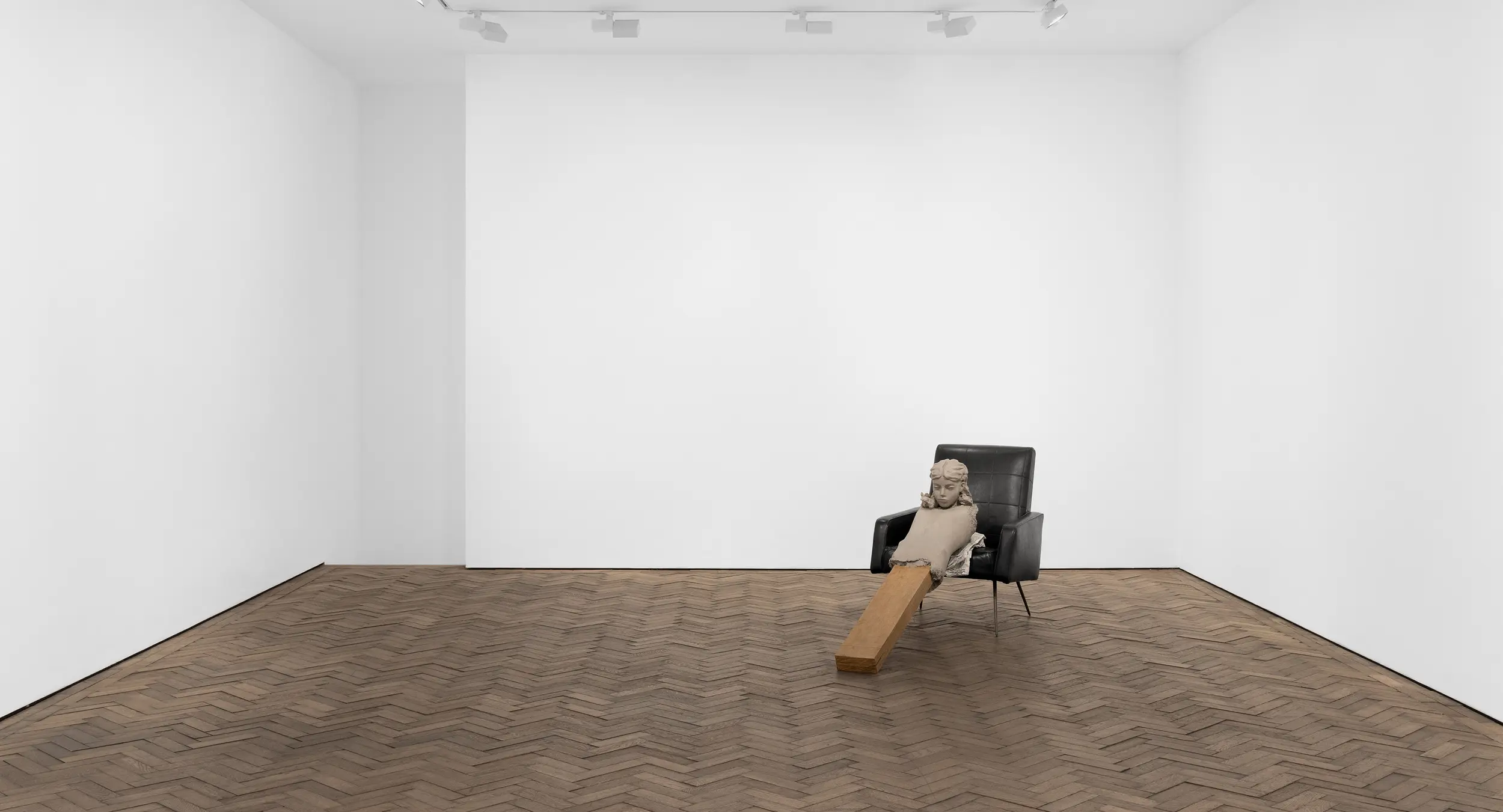
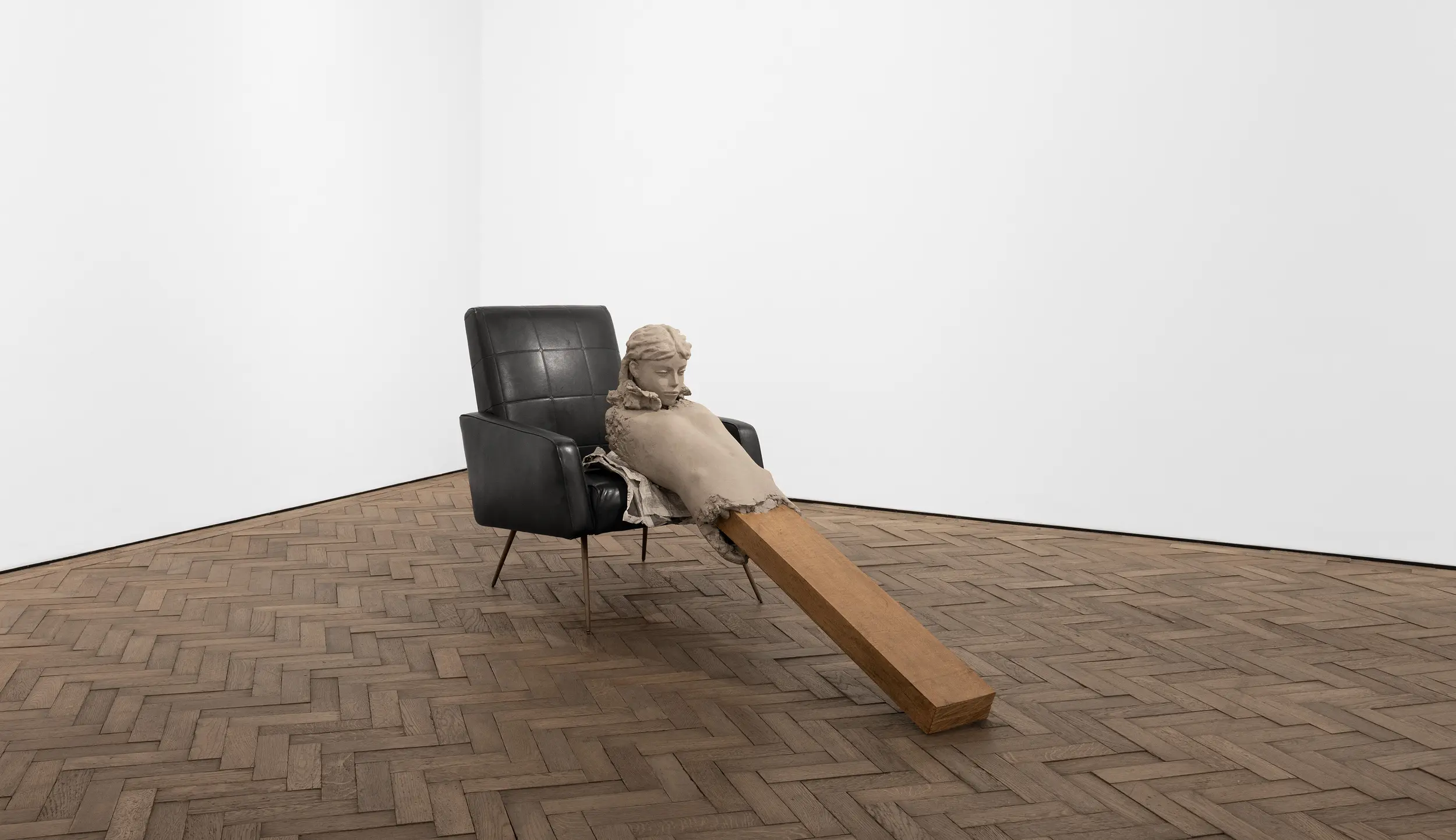
His sculptural works frequently portray anonymous figures, cast in bronze, though with the outward appearance and texture of dried or wet clay. One such example is a bronze edition of Ramble Room Chair (2010–2025), installed in the ground-floor gallery. The sculpture comprises a clay-like figure resting on a domestic chair. Possessing no arms or lower torso—a wooden plank holds the body like proxy legs—the sculpture seems vulnerable and dependent, yet at the same time peaceful, serene and totally at ease.
“All my works exist in one moment. If you zoom in on this particular work, you discover that the newspaper, which protects the chair from the wet clay of the figure, is not an everyday newspaper.
I couldn’t use a real newspaper since this fragment of my work would then be linked to a certain date and place in the world. All my works appear as if they have just been made and were left behind by the person who made them. There is no difference between a work made twenty-four years ago or just a single day ago. Like the words in an encyclopaedia, they are linked together in one big super-moment that is always attached to the here and now. The newspapers are made of all the existing words in the English language. Each word is used only once.
The wet clay figure is made around a piece of wood, and the scale feels like it is too small, like the scale does not match the real world. When I made the piece, I imagined the feeling of not having arms. Without arms and legs, the world feels dangerous, and you are totally vulnerable. I wanted the figure to be very silent, sure and at ease despite the scale and not having legs and arms. This figure seems like it had just been made and is constantly left behind.”
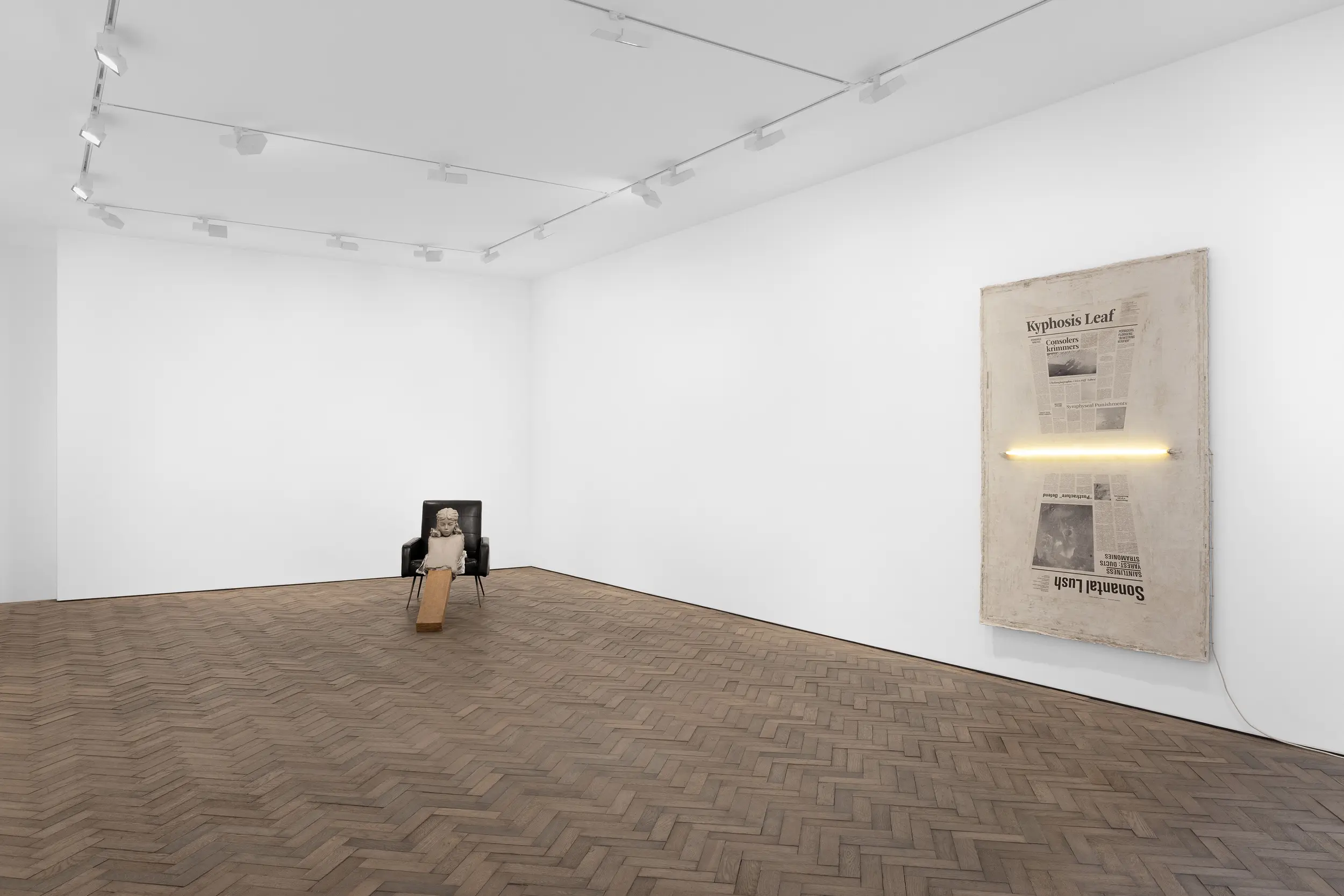
Upon closer inspection, the figure does not directly touch the painted bronze chair but instead rests on a stack of newspapers. These are not ordinary newspapers, which would be tied to a specific date and place, but the artist’s own Notional Newspapers, created over nearly twenty years and containing every word in the English language.On the other side of the room, the same newspapers appear in Perspective Study (2005–2024), where two stretched newspaper pages are separated by a fluorescent tube.
“Since the Renaissance every artist should make at least one perspective study. This study is made of fake newspapers and contains every single English word once.”
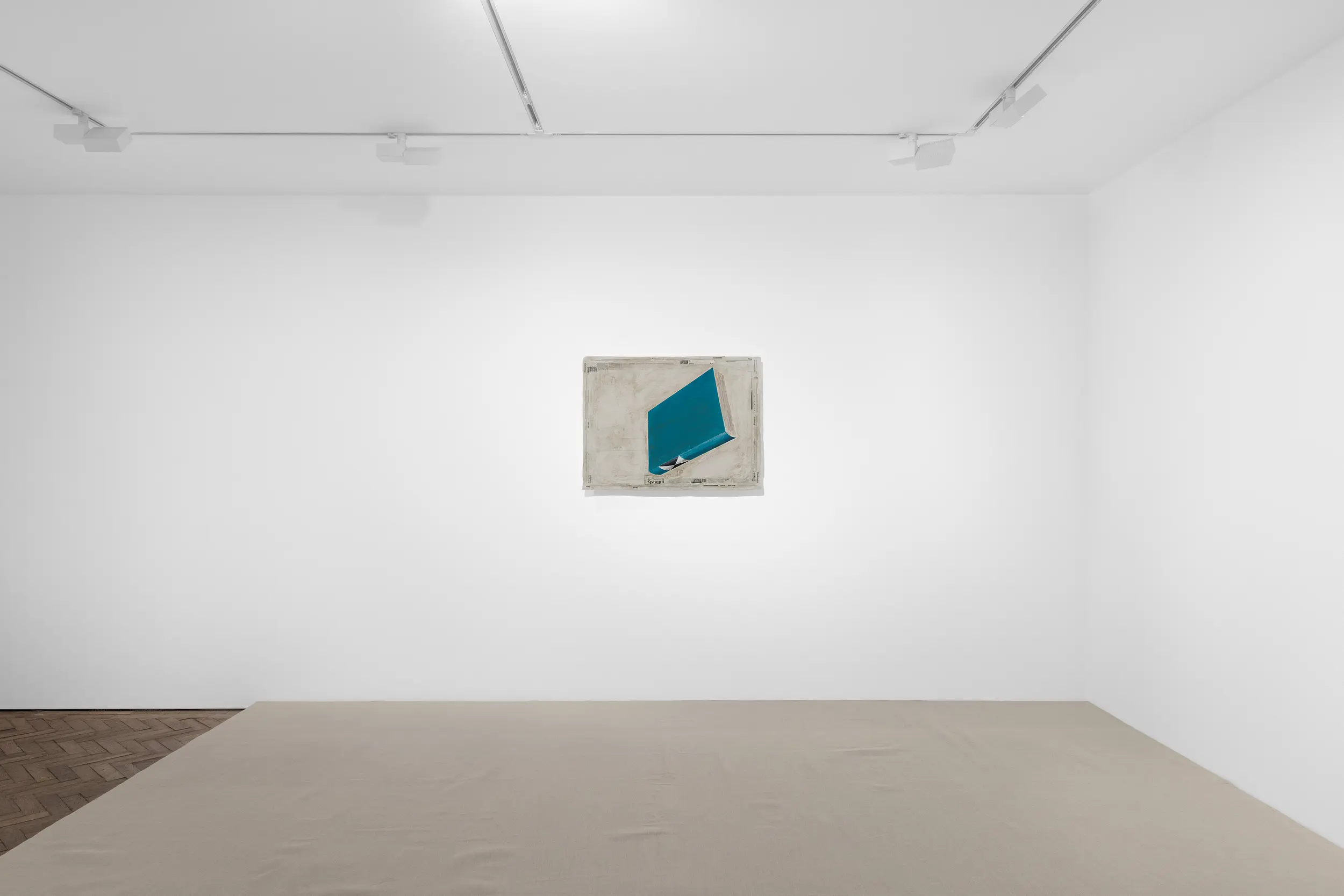
"This room is a small tribute to language and how language relates to the world, to images and our minds.
The image of the word combination ‘Falling’ and ‘Dictionary’ is painted on a collage of the self-made notional newspapers with every single word that exists in the English language. Almost no one has ever seen a falling dictionary in real life. It is an image composed of two words from our vocabulary, which only now and then come together in reality. The image of a falling dictionary has a very clear place in our mind. We can put it together instantly; a frozen image that is all about movement and language.
The image of ‘Three Dead Birds’ is more complex and hidden under a soft floor made of unpainted canvas. Because of the softness of the floor, you can’t really feel whether you’re treading on one of the dead birds. The floor functions as a painting. Each step you take as you walk through this room becomes something special, even though we humans are basically used to treading on death. The earth is covered with a thick layer of death. Beneath each step we take on earth, there is death. In this work, it is more diluted and not knowing whether you’re standing on a dead bird becomes a problem in your head.”
Manders’ fascination with language and his ability to weave together seemingly arbitrary vocabulary ultimately come to life in the downstairs installation Small Room with Three Dead Birds and Falling Dictionary (2020–2025). On the wall hangs a painting depicting a dictionary suspended mid-fall, while a stretched canvas covers the floor, concealing three taxidermy birds in unknown locations beneath it. The awareness of their presence creates a psychological tension, making the viewer acutely conscious of each step. For Manders, the floor functions like a painting, but also like precarious earth. Like words in a sentence, Manders’ sculptures and installations can be reordered infinitely, where objects and forms create new meaning and interpretations each time. Avoiding fixed interpretation while building a world of multiple propositions.
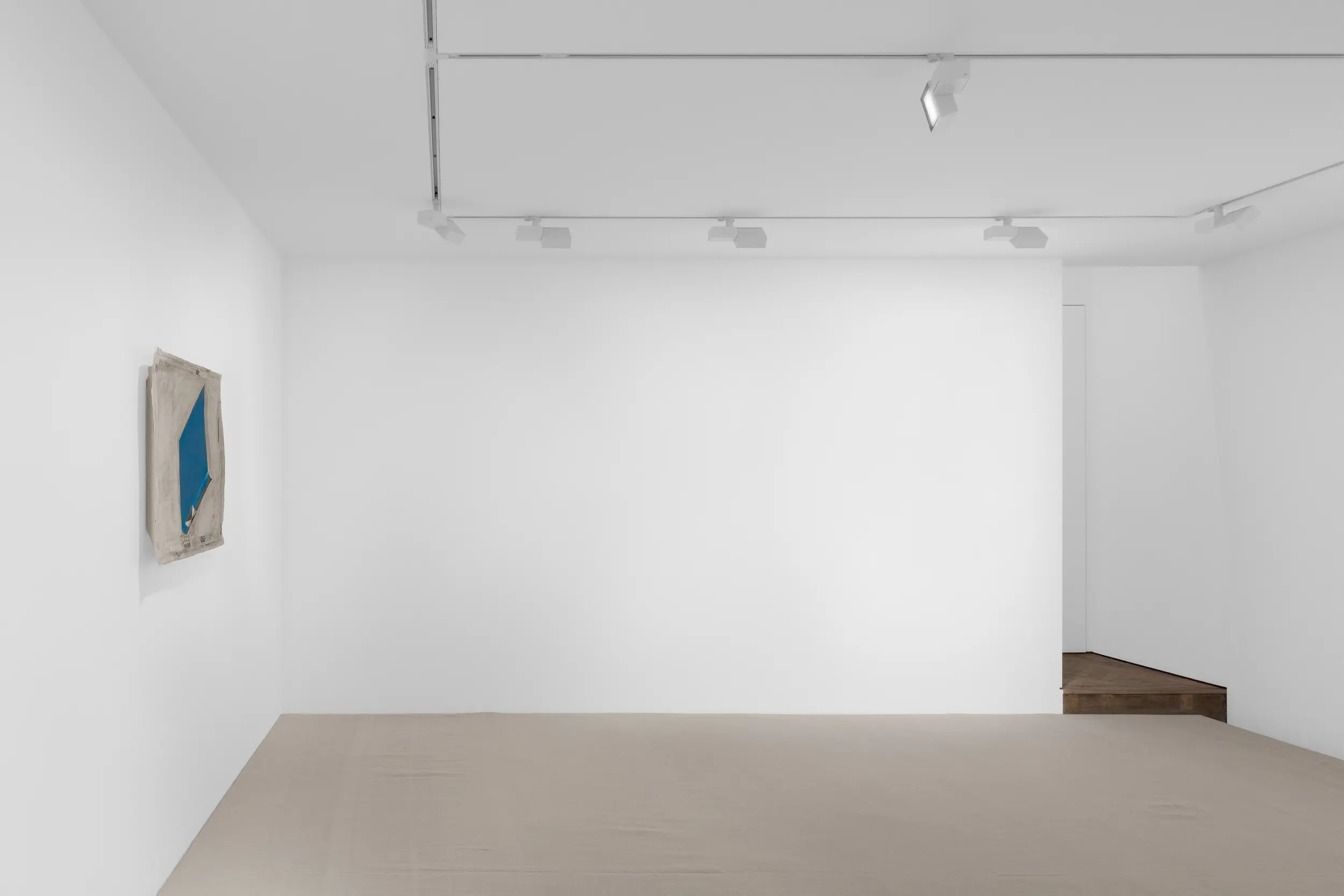
Mark Manders was born in 1968 in Volkel, Netherlands, and currently lives and works in Ronse, Belgium. His work has been the subject of recent exhibitions at Fondazione Sandretto Re Rebaudengo, Turin (2024); Woning Van Wassenhove, Ghent (2023); the Museum of Contemporary Art, Tokyo (2021); 21st Century Museum of Contemporary Art Kanazawa (2020); Bonnefanten, Maastricht (2020); Centro Galego de Arte Contemporanea, Santiago de Compostela (2014); Collezione Maramotti, Reggio Emilia (2014); De Vleeshal, Middelburg (2014); Carré d’Art – Musée d’art contemporain, Nîmes (2012); IMMA, Dublin (2005); The Art Institute, Chicago (2003); Renaissance Society, Chicago (2003); Pinakothek der Moderne, Munich (2003); amongst others. His solo show ‘Parallel Occurences / Documented Assignments’ travelled from the Hammer Museum in Los Angeles (2010) to Aspen Art Museum (2011); Walker Art Center, Minneapolis (2011); and Dallas Museum of Art (2012). ‘The Absence of Mark Manders’ toured from Kunstverein Hannover (2007) to Kunsthall Bergen (2008); S.M.A.K. in Ghent (2008) and Kunsthaus Zürich (2009).
Press Release
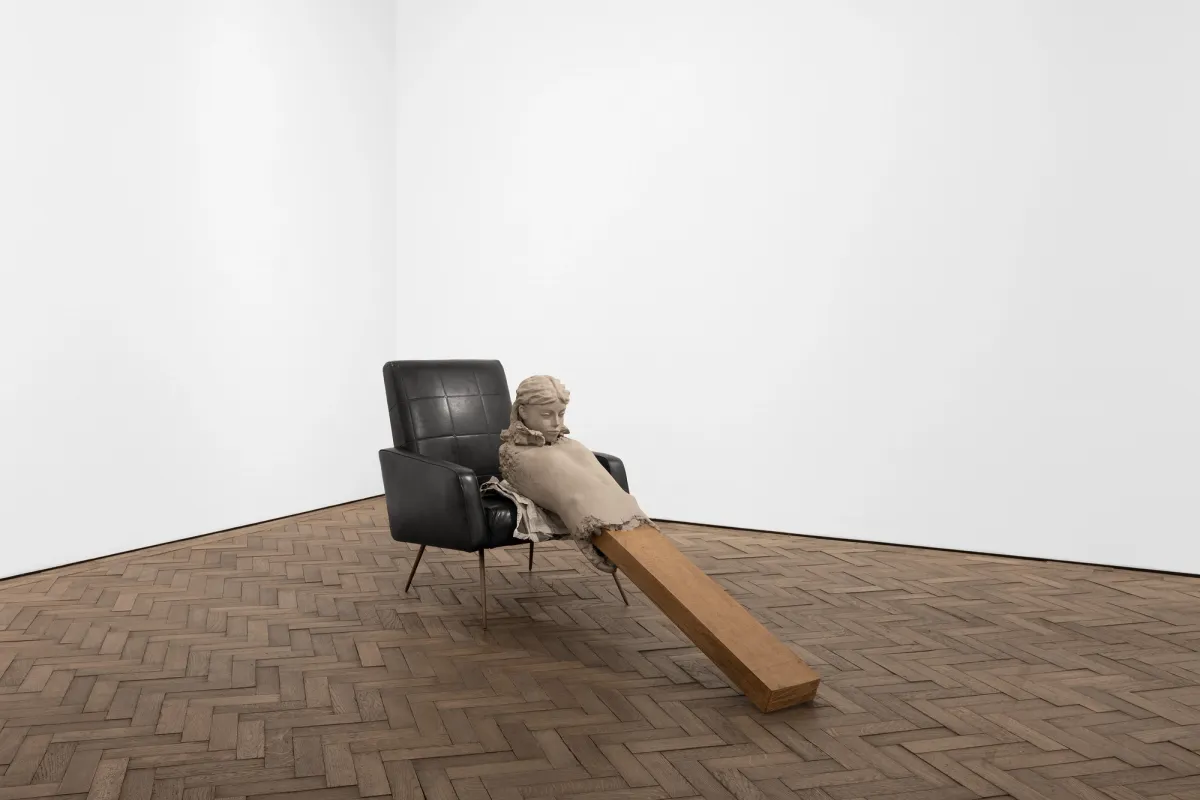
Modern Art is pleased to present Mark Manders’ first solo exhibition with the gallery since announcing his representation.
The exhibition is a continuation of Mark Manders’ ongoing project Self-Portrait as a Building, a project he began in 1986 by creating a hypothetical floor plan using small objects, such as pencils, rulers, and pieces of wood. Gradually expanding in both scale and scope, to-date, iterations of the project have materialised in sculpture, installation, painting, drawing, writing, and publishing. For this exhibition, Manders has chosen to exhibit sculptures, paintings, and a mixed-media installation.
His sculptural works frequently portray anonymous figures, cast in bronze, though with the outward appearance and texture of dried or wet clay. One such example is a bronze edition of Ramble Room Chair (2010–2025), installed in the ground-floor gallery. The sculpture comprises a clay-like figure resting on a domestic chair. Possessing no arms or lower torso—a wooden plank holds the body like proxy legs—the sculpture seems vulnerable and dependent, yet at the same time peaceful, serene and totally at ease. Upon closer inspection, the figure does not directly touch the painted bronze chair but instead rests on a stack of newspapers. These are not ordinary newspapers, which would be tied to a specific date and place, but the artist’s own Notional Newspapers, created over nearly twenty years and containing every word in the English language.On the other side of the room, the same newspapers appear in Perspective Study (2005–2024), where two stretched newspaper pages are separated by a fluorescent tube.
Manders’ fascination with language and his ability to weave together seemingly arbitrary vocabulary ultimately come to life in the downstairs installation Small Room with Three Dead Birds and Falling Dictionary (2020–2025). On the wall hangs a painting depicting a dictionary suspended mid-fall, while a stretched canvas covers the floor, concealing three taxidermy birds in unknown locations beneath it. The awareness of their presence creates a psychological tension, making the viewer acutely conscious of each step. For Manders, the floor functions like a painting, but also like precarious earth. Like words in a sentence, Manders’ sculptures and installations can be reordered infinitely, where objects and forms create new meaning and interpretations each time. Avoiding fixed interpretation while building a world of multiple propositions.
Mark Manders was born in 1968 in Volkel, the Netherlands, and currently lives and works in Ronse, Belgium. His work has been the subject of recent exhibitions at Fondazione Sandretto Re Rebaudengo, Turin (2024); Woning Van Wassenhove, Ghent (2023); the Museum of Contemporary Art, Tokyo (2021); 21st Century Museum of Contemporary Art Kanazawa (2020); Bonnefanten, Maastricht (2020); Centro Galego de Arte Contemporanea, Santiago de Compostela (2014); Collezione Maramotti, Reggio Emilia (2014); De Vleeshal, Middelburg (2014); Carré d’Art – Musée d’art contemporain, Nîmes (2012); IMMA, Dublin (2005); The Art Institute, Chicago (2003); Renaissance Society, Chicago (2003); Pinakothek der Moderne, Munich (2003); amongst others. His solo show ‘Parallel Occurences / Documented Assignments’ travelled from the Hammer Museum in Los Angeles (2010) to Aspen Art Museum (2011); Walker Art Center, Minneapolis (2011); and Dallas Museum of Art (2012). ‘The Absence of Mark Manders’ toured from Kunstverein Hannover (2007) to Kunsthall Bergen (2008); S.M.A.K. in Ghent (2008) and Kunsthaus Zürich (2009).
For more information, please contact Sam Talbot (sam@sam-talbot.com) or Pascale de Graaf (pascale@modernart.net).